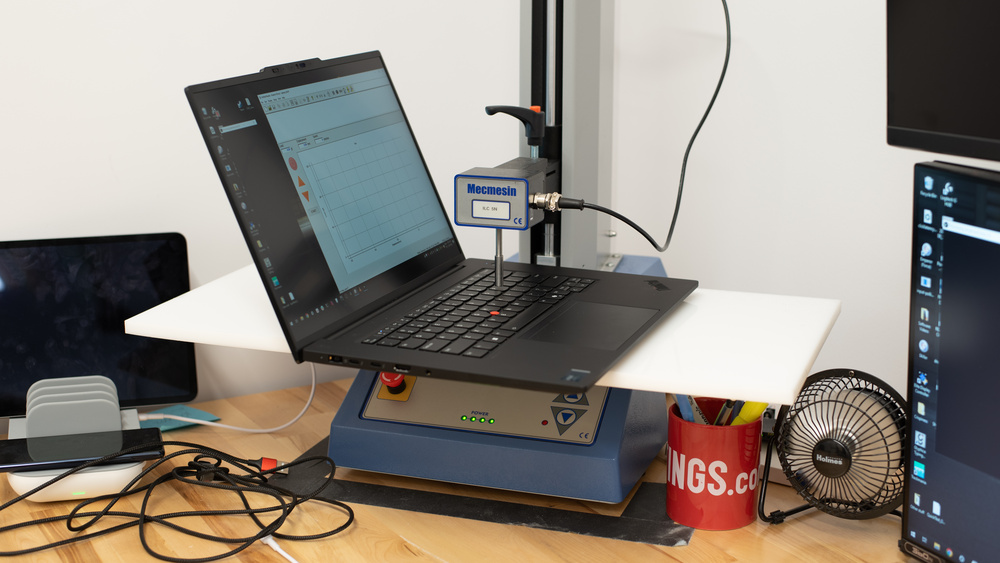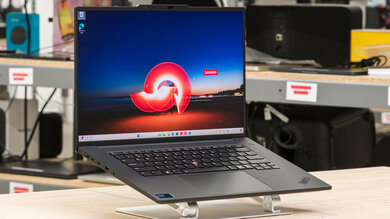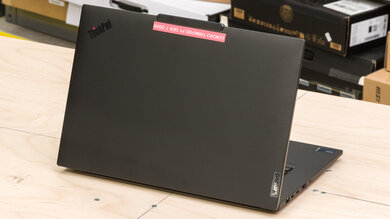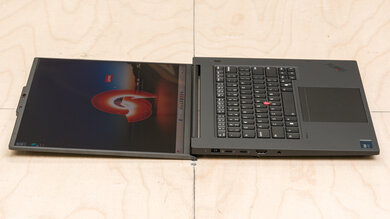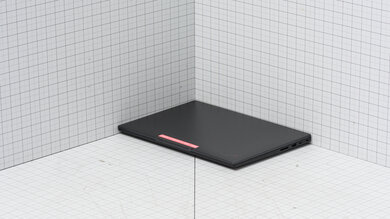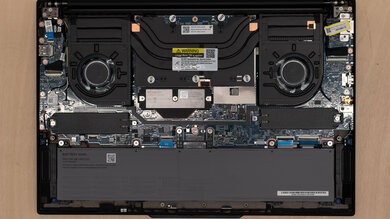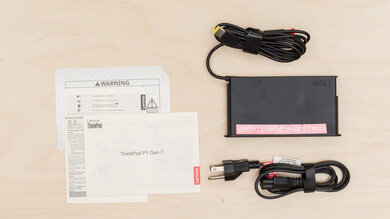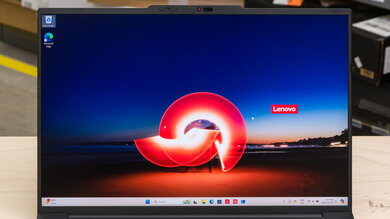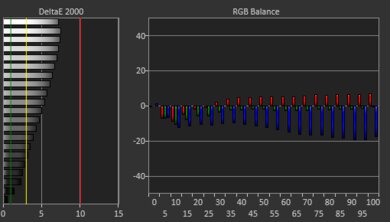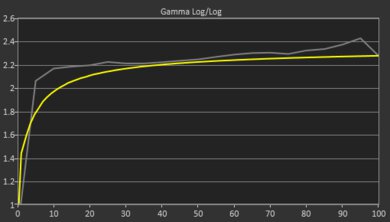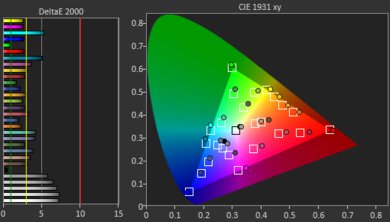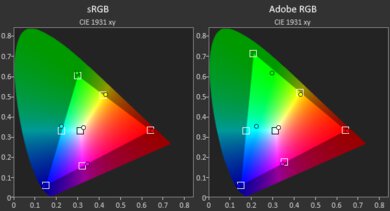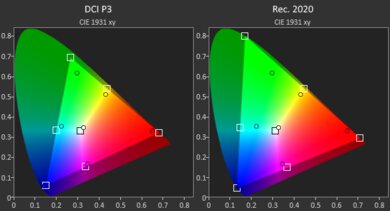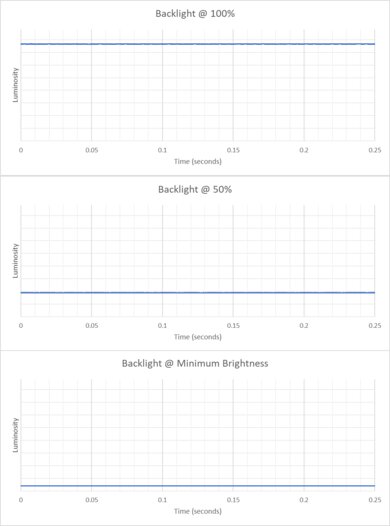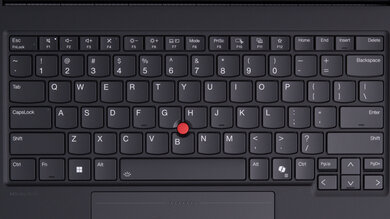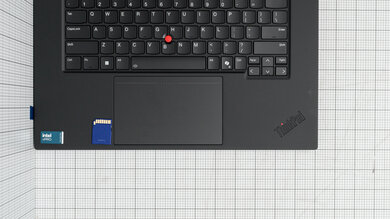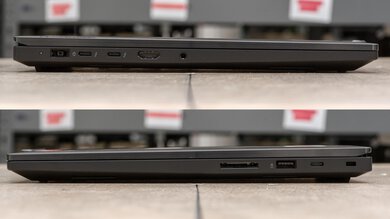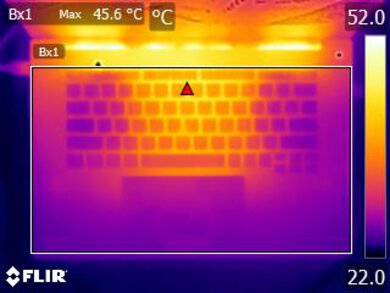The Lenovo ThinkPad P1 Gen 7 (2024) is a Windows workstation laptop. It replaces the Lenovo ThinkPad P1 Gen 6 from 2023. It's configurable with Intel Meteor Lake CPUs (up to a Core Ultra 9 185H) paired with integrated graphics, an NVIDIA GeForce RTX 40-series GPU, or an RTX Ada Generation discrete GPU. Memory and storage max out at 64GB and 8TB, respectively. Three display options are available: a 60Hz FHD+ IPS, a 165Hz QHD+ IPS, and a 60Hz 4k+ OLED panel. It has Wi-Fi 7 wireless connectivity, a 1440p webcam with Windows Hello facial recognition support, and a fingerprint sensor. Ports include three USB-Cs (two Thunderbolt 4s), a USB-A, an HDMI 2.1, and an SD Express 7.0 card reader.
See our unit's specifications and the available configuration options in the Differences Between Variants section.
Our Verdict
The Lenovo ThinkPad P1 Gen 7 is great for school use. It might not fit into some smaller bags since it's a 16-inch device; however, it's still relatively lightweight, and you won't have to worry about bringing the charger, as its battery lasts comfortably through a full school day. The overall user experience is great, as it has a nice big screen for multitasking, a comfortable keyboard, and a responsive haptic touchpad. Its Intel CPUs and NVIDIA GPUs can handle general productivity tasks and demanding workloads, making this laptop a great choice for students in fields like engineering and graphic design. You can also get this laptop with integrated graphics if you don't need a lot of GPU processing power. The fans get pretty loud under load, though, so it might not be ideal for quiet classrooms or libraries.
-
Sturdy build.
-
All-day battery life.
-
Comfortable keyboard, responsive haptic touchpad.
-
CPUs and discrete GPUs can handle demanding workloads.
-
Wide port selection.
-
Might not fit smaller bags.
-
Loud fans under load.
The Lenovo ThinkPad P1 Gen 7 is great for gaming. It's available with Intel Meteor Lake CPUs and NVIDIA discrete GPUs, which are fast enough to provide smooth gameplay in demanding AAA games. You can configure the laptop with a 165Hz QHD+ display; it has a fast response time to deliver a clear image in fast-moving scenes but lacks VRR support to reduce screen tearing. RAM and storage are user-replaceable, so you can easily add more or upgrade later. The laptop doesn't get very hot under load, though the fans are pretty loud.
-
CPUs and discrete GPUs can handle demanding workloads.
-
165Hz display option with fast response time.
-
Wide port selection.
-
User-replaceable RAM and storage.
-
Loud fans under load.
-
No VRR support.
The Lenovo ThinkPad P1 Gen 7 is good for media consumption. At 16 inches, it might not fit smaller bags; however, it's relatively lightweight, and you won't need to bring the charger since its battery lasts over 10 hours of video playback. It's available with various displays, including a QHD+ IPS and a 4k+ OLED panel. The latter is amazing for dark room viewing, as it produces deep, inky blacks, though it'll drain the battery faster. The speakers sound clear and full, with a decent amount of bass. They get very loud but sound a bit harsh at higher volume levels.
-
All-day battery life.
-
4k+ OLED panel option.
-
Loud speakers.
-
Speakers sound clear, with a decent amount of bass.
-
Might not fit smaller bags.
-
Speakers sound slightly harsh at high volume levels.
The Lenovo ThinkPad P1 Gen 7 is an outstanding workstation laptop. It's available with various Intel Meteor Lake CPUs and NVIDIA discrete GPUs, which are powerful enough to handle demanding workloads like 3D graphics and simulations. You can also use it for color-critical work like content creation, as its 4k+ OLED panel has full DCI P3 coverage. It has a comfortable keyboard, a wide port selection for peripherals and external displays, and user-replaceable RAM and storage. There's some thermal throttling on the CPU, and while the fans get loud, the keyboard deck doesn't get too hot.
-
CPUs and discrete GPUs can handle demanding workloads.
-
OLED panel has full DCI P3 coverage.
-
Wide port selection.
-
User-replaceable RAM and storage.
-
Loud fans under load.
The Lenovo ThinkPad P1 Gen 7 is excellent for business use. The overall user experience is great; you get a large screen for multitasking, a comfortable keyboard, and a responsive, easy-to-use haptic touchpad. As it's a 16-inch device, it might not fit into some bags, but it's relatively lightweight, and its battery lasts easily through a typical workday, so you won't have to worry about bringing the charger. Its Intel CPU and NVIDIA GPU can easily handle general productivity tasks like text processing and spreadsheets, and you can even edit photos and videos for your business. You get a wide port selection for peripherals and external displays, an excellent 1440p webcam for video calls, and biometrics for quick logins.
-
Sturdy build.
-
All-day battery life.
-
Comfortable keyboard, responsive haptic touchpad.
-
Wide port selection.
-
Excellent 1440p webcam.
-
Might not fit smaller bags.
- 8.3 School
- 8.3 Gaming
- 7.7 Multimedia
- 9.1 Workstation
- 8.5 Business
Changelog
-
Updated Dec 06, 2024:
Added mention of the Apple MacBook Pro 14 (2024) as a macOS alternative in the Software section.
-
Updated Dec 03, 2024:
Added the Apple MacBook Pro 16 (2024) as a faster workstation alternative in the Geekbench 5 (Synthetics) section.
- Updated Sep 16, 2024: Added mention of the Dell Precision 5690 (2024) as an alternative with more powerful GPU options for professional workloads in the GPU section.
- Updated Aug 28, 2024: We've corrected a mistake in the GPU section. The GPU is an NVIDIA RTX 3000 Ada Generation Laptop GPU, not an RTX A3000.
- Updated Aug 27, 2024: Added mention of the HP ZBook Power G11 A (2024) as an alternative with longer battery life in the Battery section.
Differences Between Sizes And Variants
We tested the Lenovo ThinkPad P1 Gen 7 with a 165Hz QHD+ IPS display, an Intel Core Ultra 7 165H CPU, an NVIDIA RTX 3000 Laptop GPU, 32GB of RAM, and 1TB of storage. The display, CPU, GPU, memory, and storage are configurable; the available options are in the table below. Our review applies only to variants with a model number starting with '21KV'.
| Screen |
|
|---|---|
| CPU |
|
| GPU |
|
| Memory |
|
| Storage |
|
| Color |
|
See our unit's label here.
Compared To Other Laptops
The Lenovo ThinkPad P1 Gen 7 is an outstanding workstation laptop. It has a sturdy build and long battery life, and it provides a great user experience overall. While there are more powerful laptops on the market, it packs a good amount of processing power without being overly bulky, making it a fantastic option for on the go use.
See our recommendations for the best Windows laptops, the best workstation laptops, and the best laptops for video editing.
The Lenovo ThinkPad P16 Gen 2 (2024) and the Lenovo ThinkPad P1 Gen 7 (2024) are both 16-inch mobile workstations; however, they're quite different, as the P16 is a much bulkier model intended as a desktop replacement, whereas the P1 Gen 7 is much more compact and better suited for on-the-go use. The latter's sleeker and more compact design comes at the cost of performance, though, as its Intel Meteor Lake CPUs aren't nearly as fast as the P16's Intel 14th Gen HX processors, and its GPU configuration maxes out at an RTX 3000 running at 60W, while the P16 Gen 2 is available with up to an RTX 5000 running at 115W. The user experience is better on the P1 Gen 7; it has a larger and more responsive haptic touchpad, a higher-quality webcam, and longer battery life. On the other hand, the P16 has more optional features, like cellular connectivity, NFC support, and a Smart Card reader.
The Apple MacBook Pro 16 (2024) and Lenovo ThinkPad P1 Gen 7 (2024) are excellent mobile workstations with wide configuration options. The Apple laptop takes the crown, offering better performance and a superior user experience. Its M4 Max SoC delivers superior CPU performance compared to the Lenovo's top-end Intel Core Ultra 9 185H, and the M4's GPU trades blows with the NVIDIA RTX 3000 Ada Generation Laptop GPU depending on the workload. As for user experience, the Apple laptop is better built and features a brighter display. The keyboard is better on the Lenovo, and while the Apple has the edge for the touchpad, the Lenovo's haptic touchpad is impressive in its own right.
Although both devices can handle demanding tasks, the Lenovo ThinkPad P1 Gen 7 (2024) and the ASUS ROG Zephyrus G14 (2024) are very different. The former is primarily a workstation laptop designed for professional workloads like design and simulation, while the latter is, first and foremost, a gaming laptop. The ThinkPad is a better choice if you want the most processing power or need more than 32GB of RAM. You can play games on the ThinkPad, but unlike the G14, none of its displays support VRR to reduce screen tearing.
If you're looking for a premium Windows workstation device, the Lenovo ThinkPad P1 Gen 7 (2024) and Dell Precision 5690 (2024) are both great choices. The user experience is similar across both laptops; they have large haptic touchpads, high-quality webcams, and significantly longer battery life than previous-generation workstations. There are options for a 4k+ OLED panel on both models as well. The keyboard is slightly better on the Lenovo, though. While both laptops are configurable with Intel Meteor Lake CPUs and NVIDIA GPUs, the hardware is the main point of difference. If you only perform workstation applications, the Dell is the better choice. It has a wider range of RTX Ada Generation Laptop GPUs than the Lenovo, up to the powerhouse RTX 5000 Ada Generation Laptop GPU. But if you want a device that can pull double duty for content creation or gaming as well, then the Lenovo is the way to go. It offers GeForce GPUs with better driver support for these applications.
The Lenovo ThinkPad P1 Gen 7 (2024) is a newer version of the Lenovo ThinkPad P1 Gen 4 (2021) and a much better device overall. The Gen 7 is available with more powerful CPUs and GPUs, and there are better display options as well, including a 165Hz QHD+ IPS and a 4k+ OLED panel. It also has a sturdier build, a larger and more responsive haptic touchpad, a higher quality 1440p webcam, and a significantly longer battery life.
The Lenovo ThinkPad P1 Gen 7 (2024) is a more versatile Windows workstation laptop than the HP ZBook Power G11 A (2024) and is better for most uses. The Lenovo is more versatile, as it offers a wider range of hardware configurations, including both NVIDIA GeForce RTX and RTX Ada Generation discrete GPUs. Both laptops feature excellent build quality, though, and use premium materials. Another point goes to Lenovo for portability; though not small (it's a 16-inch laptop), it's significantly lighter than the HP. Finally, while the HP offers a wider range of display options, the Lenovo has both IPS and OLED options; with the OLED, you can perform color-critical work using the DCI P3 color space, something that isn't possible with the HP laptop. However, if you need the longest battery life possible, go with the HP. It lasts more than 16 hours for light use.
The Lenovo ThinkPad P1 Gen 7 (2024) is much better than the Dell Precision 3591 (2024). The ThinkPad is a more premium laptop that provides a better user experience. It has a better keyboard, a larger haptic touchpad, a higher-quality webcam, and a significantly longer battery life. Also, it's available with sharper, brighter displays, including a 4k+ OLED panel. While both laptops are configurable with Intel Meteor Lake CPUs and NVIDIA GPUs, the ThinkPad has more options, as you can get it with a GeForce or RTX Ada Generation Laptop GPU, and it has a higher-end RTX 3000 Laptop GPU option as well.
The Lenovo ThinkPad P1 Gen 7 (2024) is better than the Dell XPS 16 (2024) for most uses. Although the XPS feels more premium build-wise, the ThinkPad provides a better user experience overall, as its keyboard and touchpad require less adaptation, and it has a wider port selection for peripherals and external displays. It also has longer battery life and doesn't throttle as much under load. Both laptops are available with Intel Meteor Lake CPUs and NVIDIA discreet GPUs. However, there are more GPU options on the ThinkPad, as you can configure it with an RTX Ada Generation Laptop GPU, which is better suited for professional workloads like design and simulation.
The Lenovo ThinkPad P1 Gen 7 (2024) and the Apple MacBook Pro 16 (M3, 2023) are both outstanding 16-inch workstation laptops that provide a great user experience overall. Apple's M3 Pro/Max SoCs have more CPU processing power, but you can get better graphical performance on the ThinkPad if you go with one of the higher-end GPU configurations, like an RTX 4070 or RTX 3000 Ada Generation Laptop GPU. If you want a device that you can also game on, then the ThinkPad would be a better choice because it has a 165Hz panel option with a faster response time, and there are more games on Windows. The MacBook Pro is a better option if your work requires a lot of RAM, as it's configurable with up to 128GB of memory, whereas the Lenovo maxes out at 64GB (user-upgradeable to 96GB).
Test Results
The Lenovo ThinkPad P1 Gen 7 is only available in black. See the bottom of the laptop here.
The Lenovo ThinkPad P1 Gen 7's build quality is excellent. The construction is a mix of aluminum, magnesium, and plastic. It feels very sturdy, exhibiting little to no flex on the lid or keyboard deck. The display doesn't twist when manipulating it either. While the finish doesn't scratch easily, it's a fingerprint magnet, which is typical for most dark color finishes. The feet feel solid and stick firmly to the bottom; they just attract a lot of dust and dirt.
The hinge is outstanding. It feels smooth when opening and closing the lid, and it's very stable, exhibiting almost no wobble when typing heavily or manipulating the display. Its wide range lets you push the screen back to an almost flat position, which is handy when you need to share content with someone sitting opposite you.
The Lenovo ThinkPad P1 Gen 7's serviceability is great. Accessing the internals is straightforward; you only need to remove six Philips screws and pull the bottom panel off. A prying tool isn't necessary. The screws are captive, meaning they remain attached to the bottom panel, so you don't have to worry about losing them. The RAM is user-replaceable; however, this laptop uses LPCAMM2 modules, which aren't as easy to find as the more standard SO-DIMM sticks. Both storage lots support M.2 2280 PCIe Gen 4 NVMe SSDs.
See the service guide here.
The Lenovo ThinkPad P1 Gen 7 is available with the following displays:
- 16" IPS 1920 x 1200 60Hz (matte)
- 16" IPS 2560 x 1600 165Hz (matte)
- 16" OLED 3840 x 2400 60Hz (touchscreen, glossy)
The choice of the display depends on your preference and needs. If you want the best visual experience, get the OLED panel, as it has the highest resolution and will deliver the sharpest image and text. It's also the only option with full DCI P3 coverage and support for touch input. However, keep in mind that OLEDs are susceptible to permanent burn-in. The QHD+ panel also looks very sharp and is a good choice if you care about input responsiveness and motion smoothness since it has a higher refresh rate. As for the FHD+ screen, it's fine for general productivity, but know that you'll likely see individual pixels, even at typical viewing distances, as a FHD+ resolution is low for a 16-inch display.
The Lenovo ThinkPad P1 Gen 7's QHD+ display has a high refresh rate and a fast response time, resulting in increased input responsiveness, smoother motion, and minimal ghosting behind fast-moving objects. The FHD+ and 4k+ panels have a standard 60Hz refresh rate, so they won't feel as responsive. None of the available displays support VRR to minimize screen tearing when gaming with an uncapped frame rate.
The QHD+ display’s contrast ratio is good and within the typical range of most IPS panels; however, it’s still low compared to other display technologies like VA and OLED. This contrast level makes blacks look gray in dim settings. The FHD+ panel has the same advertised contrast, while the 4k+ OLED panel has a near-infinite contrast ratio since OLEDs can turn off individual pixels to produce perfect blacks.
The QHD+ display gets bright enough for use in most indoor settings. As for outdoor use, it's doable, but you may have trouble seeing some content in direct sunlight. It gets very dim at the lowest brightness setting, which helps reduce eye strain when viewing content in a dark environment. The FHD+ panel has a lower advertised brightness of 400 cd/m². The 4k+ panel also has an advertised brightness of 400 cd/m² in SDR but can get up to 500 cd/m² in HDR.
The QHD+ display handles reflections well. Its matte finish is very effective in reducing the intensity of bright light sources, like a lamp or open window during the day. There's some haloing around bright reflections, but it's fairly minimal compared to most matte displays. The FHD+ panel has the same finish. The 4k+ panel has a glossy finish, so it'll likely struggle more with direct, mirror-like reflections.
The IPS display’s horizontal viewing angle is okay. The image dims and washes out fairly quickly when moving to the side, so you need to be close or directly in front of the screen to get perfect accuracy. As for the OLED display, it’s likely better in regards to color washout and brightness loss but will suffer more from color shift.
The IPS panel's vertical viewing angle is decent. Again, the image looks dimmer and more washed out from above or below. You need to look at the screen more or less straight on to see an accurate image.
The FHD+ and QHD+ displays are sRGB panels, meaning they only have full coverage of the commonly used sRGB color space. The 4k+ OLED panel has full DCI P3 coverage, making it a better option for HDR video production.
The Lenovo ThinkPad P1 Gen 7 has a great keyboard. Its layout is fairly standard and easy to get used to. The size of the keyboard is fine, though it could be a bit wider, considering the amount of space available on the deck. Typing on this keyboard feels great; the keys have a decent amount of travel, require little force to actuate, and provide good tactile feedback. Another minor complaint is key stability, as the keys wobble a bit.
The Lenovo ThinkPad P1 Gen 7's touchpad is outstanding. Though it could be wider, the size is good, providing ample space to perform various actions like dragging and dropping over a long distance. Tracking is outstanding, and there are no issues with palm rejection. This is a haptic touchpad, so you can click anywhere, even at the top, which is handy if you use the Trackpoint (red nub between the letters G and H). The haptic engine simulates the clicks well, giving you clear tactile feedback.
As for the Trackpoint, it's essentially a secondary way of controlling the cursor. It's convenient because you don't have to move your hand as much to move the cursor, but it's a little hard to get used to because it's pressure-sensitive.
The Lenovo ThinkPad P1 Gen 7 has outstanding speakers. They sound clear and full, with a decent amount of bass. They get very loud but sound a bit harsh at higher volume levels.
The Lenovo ThinkPad P1 Gen 7 has an excellent webcam. The image looks detailed and well-exposed, with true-to-life colors. There's some noise in darker areas, but it isn't bad enough to affect the overall quality of the image. Voices sound relatively clear, though there's a bit of static background noise.
The privacy cover is only a physical barrier, so it doesn't disable the camera or microphone at the software level. You can disable the microphone using the F4 shortcut.
The Lenovo ThinkPad P1 Gen 7 has an excellent port selection. The USB-A port supports USB 3.2 Gen 1 data transfer speed of up to 5Gbps, and it’s always on, meaning you can use it to charge a mobile device even when the laptop is in sleep mode. Both USB-Cs on the left side of the laptop support Thunderbolt 4/USB4 (up to 40Gbps data transfer speed) and DisplayPort 2.1, while the USB-C on the right side supports USB 3.2 Gen 2 (up to 10Gbps data transfer speed) and DisplayPort 1.4. All three USB-Cs support Power Delivery 3.0, which lets you fast charge the laptop and other PD-compatible devices connected to the port. However, it can only take up to 135W, so the battery might lose charge if you perform intensive tasks at the same time. Also, you must use a power adapter of at least 65W for the charging to work. The HDMI is a true HDMI 2.1 port with a maximum output resolution of 4k @ 120Hz.
The Lenovo ThinkPad P1 Gen 7's wireless adapter is an Intel Wi-Fi 7 BE200. Like Wi-Fi 6e, Wi-Fi 7 gives you access to the 6GHz band but with even faster speeds and lower latency. However, you need a router that supports Wi-Fi 7 to benefit from these features.
The Lenovo ThinkPad P1 Gen 7 is available with the following CPUs:
- Intel Core Ultra 5 135H (14 cores/18 threads, up to 4.60GHz, 18MB cache)
- Intel Core Ultra 7 155H (16 cores/22 threads, up to 4.80GHz, 24MB cache)
- Intel Core Ultra 7 165H (16 cores/22 threads, up to 5.00GHz, 24MB cache)
- Intel Core Ultra 9 185H (16 cores/22 threads, up to 5.1GHz, 24MB cache)
All four CPUs are high-performance processors from Intel's Meteor Lake family. Like Intel's 13th Gen CPUs, they have a hybrid architecture comprising performance and efficiency cores. However, they have two additional low-power E-cores (LP-E) to further improve efficiency, as well as an NPU (Neural Processing Units) for AI-based tasks, like background-blurring on video calls and image generation in photo editing apps. These CPUs can handle general productivity tasks and more intensive workloads, like programming and video editing. Regarding core composition, the Core Ultra 5 has four performance cores, eight efficiency cores, and two low-power efficiency cores (4P+8E+2LP-E), while the Core Ultra 7s and 9 have six performance cores, eight efficiency cores, and two low-power efficiency cores (6P+8E+2LP-E). All four CPUs have the same Neural Processing Units (NPU).
See more information about the Meteor Lake CPUs here.
The Lenovo ThinkPad P1 Gen 7 is available with the following GPUs:
- Intel Arc Graphics (integrated)
- NVIDIA GeForce RTX 4060 Laptop GPU (discrete, 8GB GDDR6, 60W TGP)
- NVIDIA GeForce RTX 4070 Laptop GPU (discrete, 8GB GDDR6, 60W TGP)
- NVIDIA RTX 1000 Ada Generation Laptop GPU (discrete, 6GB GDDR6, 60W TGP)
- NVIDIA RTX 2000 Ada Generation Laptop GPU (discrete, 8GB GDDR6, 60W TGP)
- NVIDIA RTX 3000 Ada Generation Laptop GPU (discrete, 8GB GDDR6, 60W TGP)
Although the NVIDIA discrete GPUs are all based on the Ada Lovelace architecture and can handle demanding tasks, some differences exist between the GeForce and the RTX Ada Generation models. The GeForce GPUs are more mainstream processors typically found in gaming and content creation laptops, while the RTX Ada Generation GPUs are designed mainly for professional workloads, with better optimization for tasks like design and simulation. These GPUs range from entry-level to mid-range. Considering only the number of CUDA cores, the RTX 1000 is the weakest, with 2,560 CUDA cores, the same number as the entry-level, gaming-oriented GeForce RTX 4050 Laptop GPU. The RTX 4060 and RTX 2000 have 3,072, while the RTX 4070 and RTX 3000 have 4,608. Ultimately, the choice of the GPU depends on your workload, its complexity, and the speed at which you expect to complete tasks. You can play games on models with an RTX Ada Generation GPU; just know that the performance won't be as good as on models with a GeForce GPU, as they don't always get the best drivers. You can also get this laptop with Intel-integrated graphics only if you don't need a lot of GPU processing power. If you need higher-end GPUs for your workflow, consider the Dell Precision 5690 (2024).
See here for more information about the GeForce GPUs, and here for more information about the RTX Ada Generation GPUs.
You can configure the Lenovo ThinkPad P1 Gen 7 with 16GB, 32GB, or 64GB of RAM. The memory is user-replaceable.
You can configure the Lenovo ThinkPad P1 Gen 7 with 256GB, 512, 1TB, 2TB, or 8TB of storage. The 2TB option can be either with a single SSD or with two SSDs in a RAID configuration (0 or 1), and the 8TB option is only available with two 4TB SSDs, also in RAID 0 or 1. Lenovo labels some SSDs as ‘Performance’ drives, but it’s unclear what that means, as there’s no mention of the exact SSD model or the expected speeds. The storage is user-replaceable; both slots support M.2 2280 PCIe Gen 4 NVMe SSDs.
The Lenovo ThinkPad P1 Gen 7's overall score in Geekbench 5 is outstanding. Its Intel Core Ultra 7 165H has strong single- and multi-thread performance, making it suitable for a variety of productivity tasks, including demanding workloads like programming and simulations. The Core Ultra 5 135H is slower, particularly in multi-threaded workloads, since it has two fewer performance cores. As for the Core Ultra 7 155H and Core Ultra 9 185H, the former is also a tad slower, while the latter is a little faster, but the difference isn't significant, as they only differ in clock speeds. If you don't need a Windows laptop for your workflow, consider the new M4 SoC Apple MacBook Pro 16 (2024) as an alternative with significantly faster performance.
The GPU compute score is outstanding and in the expected range for an NVIDIA RTX 3000 Ada Generation Laptop GPU. The GeForce RTX 4070's performance is likely in the same ballpark, while the other GPUs will be slower, with the RTX 1000 being the slowest. Intel's integrated Arc graphics perform poorly and aren't suitable for heavy computing tasks.
Here are some additional benchmarks in Geekbench 6:
- CPU Single-thread: 2,368
- CPU Multi-thread: 12,690
- GPU Compute: 103,310
The Lenovo ThinkPad P1 Gen 7 scores well in the Cinebench R23 benchmark. Its Intel Core Ultra 7 165H CPU's performance is suitable for heavily multi-threaded, sustained workloads. That said, there are significantly faster CPUs on the market, like the Dell Alienware m18 R2 (2024)'s Intel 14th Gen CPUs and the Apple MacBook Pro 16 (M3, 2023)'s M3 Max SoC.
We've also performed additional benchmarks in Cinebench 2024 in case you're more familiar with those numbers. Here are the results:
- Single-thread: 106
- Multi-thread: 957
The Lenovo ThinkPad P1 Gen 7 is outstanding for Blender work. It's best to get a model with a discrete GPU, as even the lowest-end NVIDIA RTX 1000 GPU can render images faster than the CPU or Intel's Arc-integrated graphics.
The Basemark GPU score is outstanding and in the expected range for an NVIDIA RTX 3000 Ada Generation Laptop GPU. All models with a discrete GPU can handle gaming; you just have to tweak the settings a bit, depending on the GPU model. Intel Arc is an integrated GPU designed for light productivity, so don't expect to play anything intensive.
Models with integrated graphics only will likely have longer battery life. On the other hand, models with an OLED panel will have shorter battery life. If you want even better battery performance, consider the HP ZBook Power G11 A (2024).
The Lenovo ThinkPad P1 Gen 7 with an Intel Core Ultra 7 165H CPU and an NVIDIA RTX 3000 GPU runs Borderlands 3 pretty smoothly. That said, if you want the best gaming experience in this or other similarly demanding titles, it's best to get a model with a GeForce GPU. The Intel Arc integrated graphics can't handle such a graphically intensive game.
Every configuration with a discrete GPU can run Civilization VI and other similarly demanding games smoothly with no issues. Intel’s Arc integrated graphics can handle this game, but you’ll have to dial down the settings a bit to get playable frame rates.
Every configuration of the Lenovo ThinkPad P1 Gen 7 with a discrete GPU can easily handle Counter-Strike 2 and other similarly demanding games. Intel's integrated Arc graphics can push over 30 fps with low settings, but the gameplay will likely be too choppy to be playable.
Every configuration with a discrete GPU can run Shadow of the Tomb Raider and other similarly demanding games smoothly at 1080p or 1440p. You can likely get above 30 fps using the integrated Intel Arc GPU, but the gameplay will be very choppy due to frame drops. The large frametime spikes are scene changes and aren't representative of the performance.
See the thermal image of the bottom here.
The Lenovo ThinkPad P1 Gen 7 has many pre-installed applications, including:
- Dolby Access: Adds Dolby Atmos support and allows you to change the speakers' sound profile.
- Glance by Mirametrix: A software application that adds attention-sensing capability. When enabled, it can automatically lock your computer when you walk away, pause a video, blur the content when you aren't directly looking at the screen, or move windows from one screen to another.
- Intel Management and Security Status: Lets you view the status and change settings for Intel's Active Management Technology, which allows for remote out-of-band management of business computers.
- Intel Connectivity Performance Suite: Settings to improve network performance.
- Intel Graphics Command Center: Lets you adjust the display's contrast, color, saturation, power management, and video enhancement settings.
- Intel Unison: Lets you connect your smartphone to the laptop, allowing you to send and receive messages, view photos on your smartphone, and transfer files, similar to the MyPhone app.
- Lenovo Commercial Vantage: Lets you view system status, change various settings, and give access to IT admins to troubleshoot and fix issues.
- Solitaire & Casual Games: Solitaire, FreeCell, Spider, Mahjong, Sudoku, and other casual games.
- Synaptics Fingerprint Reader Preboot Manager: Lets you access settings for the fingerprint sensor.
- Trackpoint Quick Menu: Lets you access Trackpoint settings.
You can get the Lenovo ThinkPad P1 Gen 7 with Windows 11 Home or Pro, Windows 10 Government Edition 64, Fedora Linux, Ubuntu Linux LTS, or Red Hat Enterprise Linux 9.2. You can also get it with no pre-installed operating system if you want to install a custom OS. Check out the Apple MacBook Pro 14 (2024) if you prefer to work on macOS.
The Lenovo ThinkPad P1 Gen 7 has a fingerprint sensor (integrated into the power button) and a Windows Hello facial recognition IR camera. You can use either to log in quickly, authorize purchases in the Windows Store, and auto-fill saved passwords on supported websites.
Comments
Lenovo ThinkPad P1 Gen 7 (2024): Main Discussion
Let us know why you want us to review the product here, or encourage others to vote for this product.
We’ve just released a new video that mentions the Sony BRAVIA 9 QLED here.

